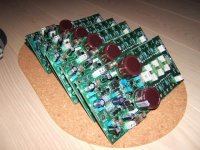“I always recommend that the grounds are kept separate until they reach CSG”
I “design” with four separate grounds; pos decouple, neg decouple, Zobel and signal+feedback. You can then connect them (I use heavy gauge stranded wire) as you see fit. But what do I know - I’m a non-professional in this field, but never too old to learn.
On another note, I can’t find any ‘scope traces of the Leach. Considering so many have been made, I find that surprising (maybe I’m not looking hard enough). So, here’s a few of mine.
Note the slight overhang on negative recovery from clipping at 10kHz. I’m not troubled by it, (I’ve seen worse) but is this normal for the Leach? Maybe an anti-sat diode across C11?
What is the “accepted” S/N ratio ref. 0 dBm for this amp (assuming sensible grounding topology)? It doesn’t appear to be quoted in any documentation I’ve seen.
Regards,
Brian.
I “design” with four separate grounds; pos decouple, neg decouple, Zobel and signal+feedback. You can then connect them (I use heavy gauge stranded wire) as you see fit. But what do I know - I’m a non-professional in this field, but never too old to learn.
On another note, I can’t find any ‘scope traces of the Leach. Considering so many have been made, I find that surprising (maybe I’m not looking hard enough). So, here’s a few of mine.
Note the slight overhang on negative recovery from clipping at 10kHz. I’m not troubled by it, (I’ve seen worse) but is this normal for the Leach? Maybe an anti-sat diode across C11?
What is the “accepted” S/N ratio ref. 0 dBm for this amp (assuming sensible grounding topology)? It doesn’t appear to be quoted in any documentation I’ve seen.
Regards,
Brian.
Attachments
Hi Lineamp,
Thanks for the comments. You appreciate things not whizzing around or untold dead end links as well. I'm happy with my 'laid back' website - it's one I can manage without an HTML expert. It communicates, that's 100% achievement to me.
Hi Pingrs,
You're shots are excellent. The levels are left out though except of course clipping. All 1W/8R? I wouldn't worry about that little overhang - try it with a load, even 16R.
How about some FFTs so we can analyse. Would be interesting.
Cheers,
Greg
Thanks for the comments. You appreciate things not whizzing around or untold dead end links as well. I'm happy with my 'laid back' website - it's one I can manage without an HTML expert. It communicates, that's 100% achievement to me.
Hi Pingrs,
You're shots are excellent. The levels are left out though except of course clipping. All 1W/8R? I wouldn't worry about that little overhang - try it with a load, even 16R.
How about some FFTs so we can analyse. Would be interesting.
Cheers,
Greg
On another note, I can’t find any ‘scope traces of the Leach. Considering so many have been made, I find that surprising (maybe I’m not looking hard enough).
from the original article, march 1980, audio magazine:
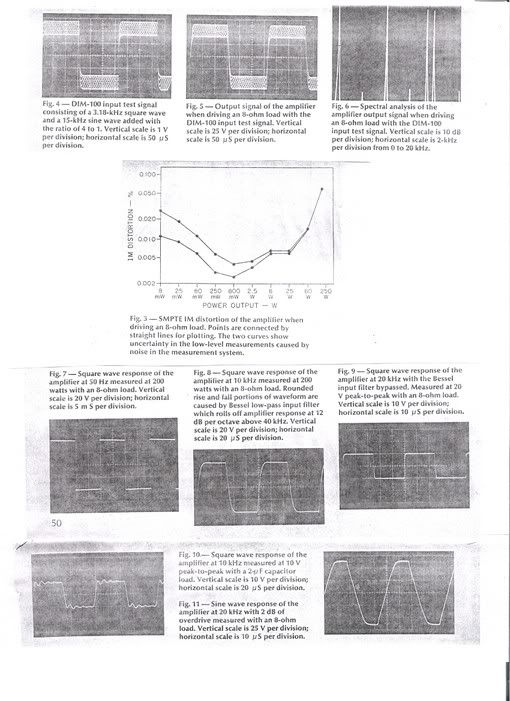
djk said:That's the big one, not bad for series connected outputs.
Which sounds better, the original or the double-barelled? Apart from the effect of improved headroom, obviously.
Thank you, gentlemen, for your response, and my apologies for the late reply.
AmpGuru, your expert comments are much appreciated.
Sorry, I should have made it clear that the on-screen switch settings applied i.e 5mV/div x 6 div= 30V.
I’d love to see some FFT’s myself, but I don’t have a soundcard good enough (and I’d need practice with Rmaa - or is AudioT better?). The measured distortion is around –83dB at 1kHz and –75dB at 10 kHz, 10V rms into 8R.
Tony, very interesting scope traces, a bit more than run-of-the-mill square waves there (how many know that they exist?) – should have asked you in the first place. Thanks.
Regards,
Brian
AmpGuru, your expert comments are much appreciated.
Sorry, I should have made it clear that the on-screen switch settings applied i.e 5mV/div x 6 div= 30V.
I’d love to see some FFT’s myself, but I don’t have a soundcard good enough (and I’d need practice with Rmaa - or is AudioT better?). The measured distortion is around –83dB at 1kHz and –75dB at 10 kHz, 10V rms into 8R.
Tony, very interesting scope traces, a bit more than run-of-the-mill square waves there (how many know that they exist?) – should have asked you in the first place. Thanks.
Regards,
Brian
Tony, very interesting scope traces, a bit more than run-of-the-mill square waves there (how many know that they exist?) – should have asked you in the first place. Thanks.
they are from the 1980 article of prof. leach which appeared in the Audio Magazine march-april editions entilled, "Build a Double Barreled Amplifier"' i have them on my hardisk. but i am using a dial-up connection so uploading will be next to impossible.
i can post them here by installment if the mods will allow it.
I wonder if amplifierguru have scope traces simmilar to those of prof leach, so we can do a side by side comparison!
bremen nacht said:
Which sounds better, the original or the double-barelled? Apart from the effect of improved headroom, obviously.
i like the original design of the super leach better! the bessel aligned filter at the input does not get in the way of the music as far as my listening tests goes, i used a pair of diy 4-way speaker system with a cabinet volume of about 6cu ft. with a 15inch woofer, a 12 inch low mid, 6 inch high mids and an array of dome tweeters.! "Hotel California" by the Eagles was rendered very loud and yet not irritating to listen to even at extended high volume levels! i kept playing that song over and over .
😀
Hi Pingrs,
..."I’d love to see some FFT’s myself, but I don’t have a soundcard good enough (and I’d need practice with Rmaa - or is AudioT better?). The measured distortion is around –83dB at 1kHz and –75dB at 10 kHz, 10V rms into 8R.'
-83 dB. Yes I guesstimated it at about 0.008% from the IM graph.
But it's the structure that's all important so FFT's a godsend for definitive assessment. You'd be surprised at the results you can obtain without much outlay. My soundblaster live was SH and I built a Q=2 bandpass filter, enough to show NO harmonics on loopback with a 110 dB noise floor. Resolution 0.0005%. At that level who cares what it's made of.
Where it's really useful is in doing a wiring loom and product chassis layout. It's worth the effort to ensure potential is not lost in implementation. Attention to detail ensures the top doesn't develop it's own character and become 'edgy' or 'tizzy'.
Cheers,
Greg
..."I’d love to see some FFT’s myself, but I don’t have a soundcard good enough (and I’d need practice with Rmaa - or is AudioT better?). The measured distortion is around –83dB at 1kHz and –75dB at 10 kHz, 10V rms into 8R.'
-83 dB. Yes I guesstimated it at about 0.008% from the IM graph.
But it's the structure that's all important so FFT's a godsend for definitive assessment. You'd be surprised at the results you can obtain without much outlay. My soundblaster live was SH and I built a Q=2 bandpass filter, enough to show NO harmonics on loopback with a 110 dB noise floor. Resolution 0.0005%. At that level who cares what it's made of.
Where it's really useful is in doing a wiring loom and product chassis layout. It's worth the effort to ensure potential is not lost in implementation. Attention to detail ensures the top doesn't develop it's own character and become 'edgy' or 'tizzy'.
Cheers,
Greg
Tony said:
they are from the 1980 article of prof. leach which appeared in the Audio Magazine march-april editions entilled, "Build a Double Barreled Amplifier"' i have them on my hardisk. but i am using a dial-up connection so uploading will be next to impossible.
i can post them here by installment if the mods will allow it.
I wonder if amplifierguru have scope traces simmilar to those of prof leach, so we can do a side by side comparison!
Double barreled amplifier here:
http://users.ece.gatech.edu/~mleach/superamp/
still4given said:
Hi Dave,
I have no complaints about the bass in the Leach. It is very strong and clear.
Here's a pic of the inside of mine. You can see that I have one star ground for everything.
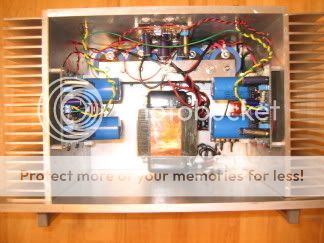
Blessings, Terry
Hey Terry, Where did you get your enclosure?
Thanks,
Jonathon
frckid said:
Hey Terry, Where did you get your enclosure?
Thanks,
Jonathon
Hi Jonathon,
I made it out of some scrap aluminum plate that I had been saving. It was mostly 1/4" thick. I won't do that again, the case alone weighs almost 20lbs. 😀
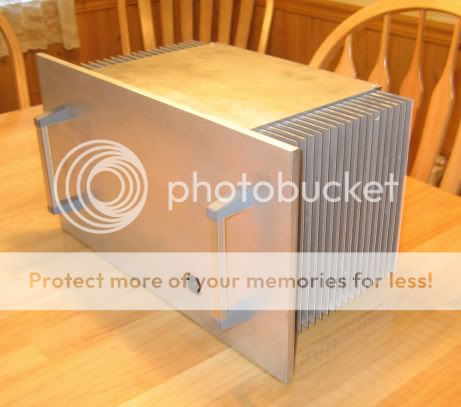
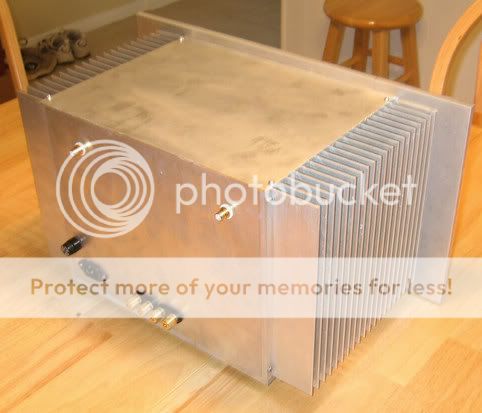
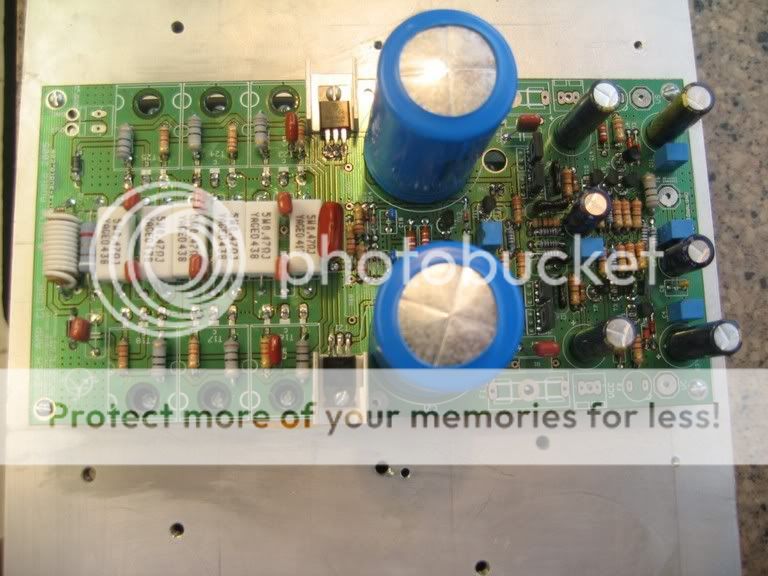
Blessings, Terry
Just thought of something - How critical are the 1% / Metal films. Will they make a big differeance compared to 5% carbons?
Ross,
DC on the output will be smaller with 1% resistors, and even smaller if you match your transistors.
5% resistors may give you up to 100mV of DC depending on your transistors
\Jens
DC on the output will be smaller with 1% resistors, and even smaller if you match your transistors.
5% resistors may give you up to 100mV of DC depending on your transistors
\Jens
THX for the quick reply Jens. I was just concened that one or the other types of resistors may have some sort of audible "sonic signature". I have used metal films for many years now as they are the same price as carbons.
When building my first 2 channels I did match the input & driver Transistors (Not Power) and have happily ended up with 8mV & 14mV offset. Matching the MPSA's was quite a task as their gains varied quite widely even though they were from the same batch. HFE's ranged from 90 to over 200 for the one batch 😱 and of course the complimentary transistors only had a small overlap in the sample range.
Building the Leach on your board through was / is such a pleasure.
Cheers
When building my first 2 channels I did match the input & driver Transistors (Not Power) and have happily ended up with 8mV & 14mV offset. Matching the MPSA's was quite a task as their gains varied quite widely even though they were from the same batch. HFE's ranged from 90 to over 200 for the one batch 😱 and of course the complimentary transistors only had a small overlap in the sample range.
Building the Leach on your board through was / is such a pleasure.
Cheers
Hi Guys,
I have had a weird occourance. I stacked all of my amps on top of each other and when I turn on more than two of them I hear a bezzing sound. It is not coming from the speaker but from the amps themselves. Any idea what is causing this and what I might have to do to make it go away?
Thanks, Terry
I have had a weird occourance. I stacked all of my amps on top of each other and when I turn on more than two of them I hear a bezzing sound. It is not coming from the speaker but from the amps themselves. Any idea what is causing this and what I might have to do to make it go away?
Thanks, Terry
Ross,
I will report on DC when I have some more "statistics" from the 8 channels I'm building.
6 will be with the boards from the GB and 2 will be with the extended version.
I use 1% resistors but never bother to match transistors. I firmly believe that it should no be necessary to match transistors if you use 1% resistors. This has not been verified on more than 2 boards, but I will post measurements when I have more channels up and running.
Terry,
You can use 2 diodes reversed in parallel and paralled with a 470µF 16V cap. Connect this in series with your transformer on the mains side - Take care when working with mains connected stuff


\Jens
I will report on DC when I have some more "statistics" from the 8 channels I'm building.
6 will be with the boards from the GB and 2 will be with the extended version.
I use 1% resistors but never bother to match transistors. I firmly believe that it should no be necessary to match transistors if you use 1% resistors. This has not been verified on more than 2 boards, but I will post measurements when I have more channels up and running.
Terry,
You can use 2 diodes reversed in parallel and paralled with a 470µF 16V cap. Connect this in series with your transformer on the mains side - Take care when working with mains connected stuff



\Jens
- Status
- Not open for further replies.
- Home
- Amplifiers
- Solid State
- Smaller Leach Amp V1
